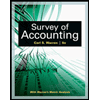
ACCT INFO SYSTEMS (ACCESS CODE)
11th Edition
ISBN: 9781337599320
Author: GELINAS
Publisher: CENGAGE L
expand_more
expand_more
format_list_bulleted
Question
Chapter 16, Problem 12RQ
Summary Introduction
To explain: The impact of the Sarbanes-Oxley act of 2002 on the GL/BR process.
Introduction:
General ledger/business reporting process (GL/BR):
General ledger can be defined as the central data repository needed to develop the business reports. The business reports and other forms of information generation are all derived from the general ledger data repository. The GL/BR process is considered as a central activity of the
Expert Solution & Answer
Want to see the full answer?
Check out a sample textbook solution
Students have asked these similar questions
When the price of a bond is above the face value, the bond is said to be*
Trading at par
Trading at a premium
Trading at a discount
Trading below par
7. What is a par value of a bond?*
The amount borrowed by the issuer of the bond and returned to the investors when the bond matures
The overall return earned by the bond investor when the bond matures
The difference between the amount borrowed by the issuer of bond and the amount returned to investors at maturity
The size of the coupon investors receive on an annual basis
What is an annuity?*
An investment that has no definite end and a stream of cash payments that continues forever
A stream of cash flows that start one year from today and continue while growing by a constant growth rate
A series of equal payments at equal time periods and guaranteed for a fixed number of years
A series of unequal payments at equal time periods which are guaranteed for a fixed number of years
Chapter 16 Solutions
ACCT INFO SYSTEMS (ACCESS CODE)
Ch. 16 - Prob. 1RQCh. 16 - Prob. 2RQCh. 16 - Prob. 3RQCh. 16 - What, in your own words, are a performance report...Ch. 16 - Prob. 5RQCh. 16 - Prob. 6RQCh. 16 - What limitations are faced by contemporary...Ch. 16 - Prob. 8RQCh. 16 - Prob. 9RQCh. 16 - Prob. 10RQ
Ch. 16 - Prob. 11RQCh. 16 - Prob. 12RQCh. 16 - Prob. 1DQCh. 16 - Prob. 2DQCh. 16 - Prob. 3DQCh. 16 - Prob. 4DQCh. 16 - Prob. 5DQCh. 16 - Prob. 6DQCh. 16 - Prob. 7DQCh. 16 - Prob. 8DQCh. 16 - Prob. 1SPCh. 16 - Prob. 2SPCh. 16 - Prob. 1PCh. 16 - Prob. 4PCh. 16 - Prob. 5PCh. 16 - Prob. 8PCh. 16 - Prob. 10P
Knowledge Booster
Similar questions
- If you were able to earn interest at 3% and you started with $100, how much would you have after 3 years?* $91.51 $109.27 $291.26 $103.00arrow_forwardNo AI 2. The formula for calculating future value (FV) is* FV = PV/(1+r)^n FV = PV/(1+r)*n FV = PV x (1+r)^n FV = PV x (1+r)*narrow_forwardDividend??? solnarrow_forward
- Hello tutor need barrow_forwardMoose Enterprises finds it is necessary to determine its marginal cost of capital. Moose’s current capital structure calls for 50 percent debt, 30 percent preferred stock, and 20 percent common equity. Initially, common equity will be in the form of retained earnings (Ke) and then new common stock (Kn). The costs of the various sources of financing are as follows: debt, 9.6 percent; preferred stock, 9 percent; retained earnings, 10 percent; and new common stock, 11.2 percent. a. What is the initial weighted average cost of capital? (Include debt, preferred stock, and common equity in the form of retained earnings, Ke.) b. If the firm has $18 million in retained earnings, at what size capital structure will the firm run out of retained earnings? c. What will the marginal cost of capital be immediately after that point? (Equity will remain at 20 percent of the capital structure, but will all be in the form of new common stock, Kn.) d. The 9.6 percent cost of debt referred to earlier…arrow_forward7. Berkeley Farms wants to determine the minimum cost of capital point for the firm. Assume it is considering the following financial plans: Cost (aftertax) Weights Plan A Debt .................................. 4.0% 30% Preferred stock .................. 8.0 15 Common equity ................. 12.0 55 Plan B Debt .................................. 4.5% 40% Preferred stock .................. 8.5 15 Common equity ................. 13.0 45 Plan C Debt .................................. 5.0% 45% Preferred stock .................. 18.7 15 Common equity ................. 12.8 40 Plan D Debt .................................. 12.0% 50% Preferred stock .................. 19.2 15 Common equity ................. 14.5 35 a. Which of the four plans has the lowest weighted average cost of capital? Use the Kd (cost of debt) = Y(1 - T), Kp (Cost of preferred stock) = Dp/Pp - F, Ke = D1/P0 + g formulas or I will not understand.arrow_forward
arrow_back_ios
SEE MORE QUESTIONS
arrow_forward_ios
Recommended textbooks for you
 Accounting Information SystemsAccountingISBN:9781337619202Author:Hall, James A.Publisher:Cengage Learning,
Accounting Information SystemsAccountingISBN:9781337619202Author:Hall, James A.Publisher:Cengage Learning, Survey of Accounting (Accounting I)AccountingISBN:9781305961883Author:Carl WarrenPublisher:Cengage LearningBusiness/Professional Ethics Directors/Executives...AccountingISBN:9781337485913Author:BROOKSPublisher:Cengage
Survey of Accounting (Accounting I)AccountingISBN:9781305961883Author:Carl WarrenPublisher:Cengage LearningBusiness/Professional Ethics Directors/Executives...AccountingISBN:9781337485913Author:BROOKSPublisher:Cengage


Accounting Information Systems
Accounting
ISBN:9781337619202
Author:Hall, James A.
Publisher:Cengage Learning,


Survey of Accounting (Accounting I)
Accounting
ISBN:9781305961883
Author:Carl Warren
Publisher:Cengage Learning

Business/Professional Ethics Directors/Executives...
Accounting
ISBN:9781337485913
Author:BROOKS
Publisher:Cengage